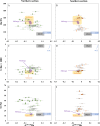Mélange dehydration and melting beneath South Sandwich Islands arc
- PMID: 39920101
- PMCID: PMC11806041
- DOI: 10.1038/s41467-025-56554-x
Mélange dehydration and melting beneath South Sandwich Islands arc
Abstract
Mechanisms regulating material transfer from subducted slabs to arc magmas remain debated, centered on metasomatized mantle wedge interactions versus mélange mobilization at the slab-mantle interface. The South Sandiwch Islands arc offers a unique setting to distinguish between these models due to the significant barium isotope contrast between altered oceanic crust and sediments, the latter displaying unusually light barium isotope compositions compared to the global sediment range. Here we show substantial barium isotope variations coupled with invariant strontium isotope ratios in arc lavas, consistent with mélange mobilization beneath the arc. Northern arc lavas display a broader range of barium isotope values than expected from slab inputs, suggesting barium isotope fractionation during slab material transport, potentially driven by phengite-related barium retention within the mélange. Notably, sediments, rather than altered oceanic crust, emerge as the dominant source of barium in arc lavas. While a comparison of barium isotope data from four additional arcs indicates mantle wedge metasomatism remains visible in several cases, mélange mobilization is consistent with available data across all of these subduction zones.
© 2025. The Author(s).
Conflict of interest statement
Competing interests: The authors declare no competing interests.
Figures






References
-
- Ishikawa, T. & Nakamura, E. Origin of the slab component in arc lavas from across-arc variation of B and Pb isotopes. Nature370, 205–208 (1994).
-
- Elliott, T., Plank, T., Zindler, A., White, W. & Bourdon, B. Element transport from slab to volcanic front at the Mariana arc. J. Geophys. Res. Solid Earth102, 14991–15019 (1997).
-
- Kessel, R., Schmidt, M. W., Ulmer, P. & Pettke, T. Trace element signature of subduction-zone fluids, melts and supercritical liquids at 120–180 km depth. Nature437, 724–727 (2005). - PubMed
-
- Spandler, C. & Pirard, C. Element recycling from subducting slabs to arc crust: a review. Lithos170-171, 208–223 (2013).
Grants and funding
LinkOut - more resources
Full Text Sources

